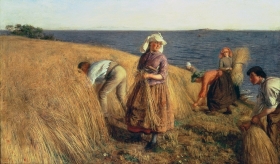Bandwin on:
[Wikipedia]
[Google]
[Amazon]
 A bandwin was a team of agricultural workers in the
A bandwin was a team of agricultural workers in the
 The term was first recorded in 1642 in the Sheriffs records for Aberdeenshire. It may be derived from the bands of stalks used to tie the sheaves of grain, or because it made up a band or group.
The term was first recorded in 1642 in the Sheriffs records for Aberdeenshire. It may be derived from the bands of stalks used to tie the sheaves of grain, or because it made up a band or group.
 A bandwin was a team of agricultural workers in the
A bandwin was a team of agricultural workers in the Scottish Lowlands
The Lowlands ( or , ; , ) is a cultural and historical region of Scotland.
The region is characterised by its relatively flat or gently rolling terrain as opposed to the mountainous landscapes of the Scottish Highlands. This area includes ci ...
before the agricultural revolution, who carried out the harvest.
The term was first recorded in 1642. The bandwin was characteristically made up of two teams of two women and a man who acted as reapers and a bandster who gathered and bound the sheaves. The work of women in the bandwin was unusually almost as valued as that of the men.
Use
 The term was first recorded in 1642 in the Sheriffs records for Aberdeenshire. It may be derived from the bands of stalks used to tie the sheaves of grain, or because it made up a band or group.
The term was first recorded in 1642 in the Sheriffs records for Aberdeenshire. It may be derived from the bands of stalks used to tie the sheaves of grain, or because it made up a band or group.
Organisation
Most members were women from theHighlands
Highland is a broad term for areas of higher elevation, such as a mountain range or mountainous plateau.
Highland, Highlands, or The Highlands, may also refer to:
Places Africa
* Highlands, Johannesburg, South Africa
* Highlands, Harare, Zimbab ...
. Characteristically they were made up of seven members: six shearers using the crescent-shaped sickle
A sickle, bagging hook, reaping-hook or grasshook is a single-handed agricultural tool designed with variously curved blades and typically used for harvesting or reaping grain crops, or cutting Succulent plant, succulent forage chiefly for feedi ...
, and a bandster who bound the sheaves. The reapers were divided into two teams, each of which worked two ridges of a runrig
Runrig were a Scottish Celtic rock band formed on the Isle of Skye in 1973. From its inception, the band's line-up included brothers and songwriters Rory MacDonald (musician), Rory MacDonald (bass, vocals) and Calum MacDonald (musician), Calum ...
. The bandster was usually a man and the two teams were ideally made up of two women and one man.H. Stephens and J. Pitkin Norton, ''The Farmer's Guide to Scientific and Practical Agriculture: Detailing the Labors of the Farmer, in All Their Variety, and Adapting Them to the Seasons of the Year as They Successively Occur, Volume 2'' (L. Scott, 1851), p. 331. The man in each team cut the longest and strongest stalks in the run middle of the group. The woman on the right hand side had the most laborious task, as she had to stretch to meet the adjacent ridge. The two women in a team would, as a result, change places every landing. A bandster could bind the corn of two teams and the six reapers could cut two acres a day.
Wages
The work of women in the bandwin was unusually almost as valued as that of the men. In the mid-eighteenth century female reapers received 5d a day, male reapers 6d a day and the bandster 7d.R. Mitchison, "Scotland 1750–1850", in F. M. L. Thompson, ''The Cambridge Social History of Britain, 1750–1950'' (Cambridge: Cambridge University Press, 1990), , p. 170.Notes
{{reflist, 30em 18th century in Scotland Agriculture in Scotland Early modern history of Scotland Economic history of Scotland History of agriculture in the United Kingdom History of agriculture